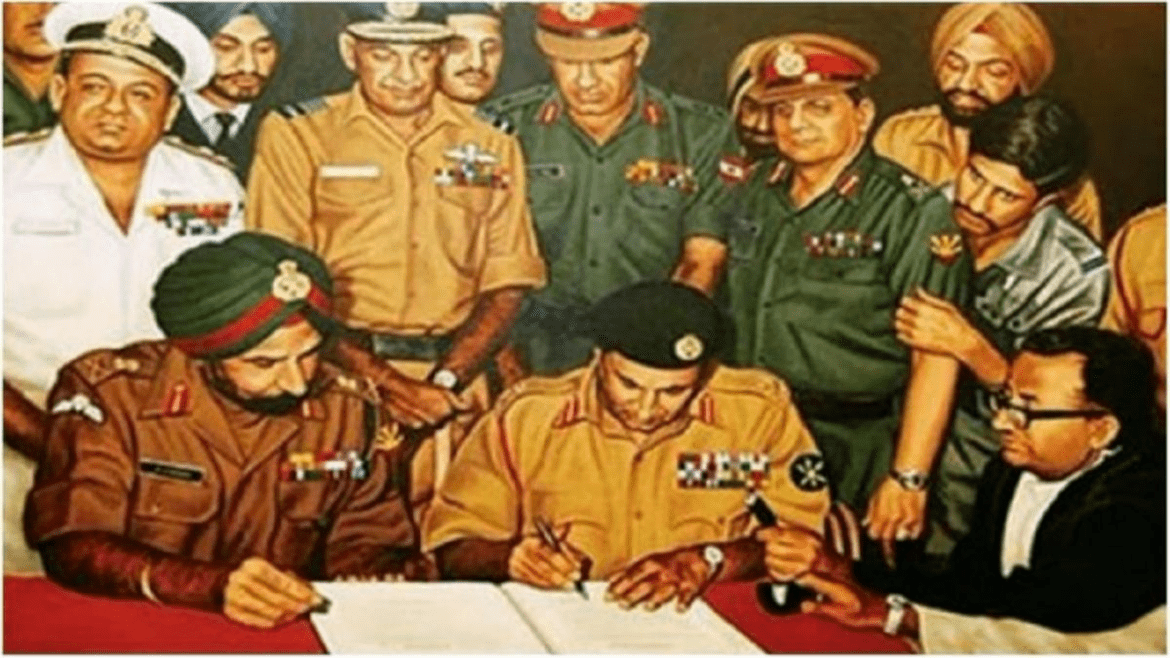AI Generated Summary
- India’s strategic triumph in the conflict was orchestrated through a series of well-executed military and psychological maneuvers that ultimately forced the fall of the Pakistani regime in Dhaka and the surrender of over 90,000 troops in East Pakistan within a fortnight of intense fighting.
- The deployment of the US Seventh Fleet was countered by the USSR’s deployment, leading to a standoff between the two superpowers and leaving Pakistan isolated in the east.
- Gen Niazi’s distress signal on December 13 was met with orders to continue fighting, but the demoralizing air strike on the Governor House in Dhaka led to the resignation of the East Pakistan government.
Yesterday, India commemorated Vijay Diwas, a momentous occasion that marks the surrender of East Pakistan troops in the 1971 war. A significant milestone in history, this event unfolded fifty-two years ago, leading to the liberation of East Pakistan and the birth of Bangladesh.
India’s strategic triumph in the conflict was orchestrated through a series of well-executed military and psychological maneuvers that ultimately forced the fall of the Pakistani regime in Dhaka and the surrender of over 90,000 troops in East Pakistan within a fortnight of intense fighting.
India’s military strategy played a pivotal role in the outcome of the war. East Pakistan was swiftly isolated from its Western counterpart as India declared a no-fly zone for Pakistani planes, establishing a naval blockade in the west to disrupt supply routes. The Indian Air Force, within three days, achieved air superiority in East Pakistan, facilitating the rapid advance of the army deep into Bangladesh.
The naval forces, led by INS Vikrant, the aircraft carrier, effectively blocked reinforcements to the east, cutting off escape routes and Sea Lines of Communication (SLOC). Simultaneously, the Indian Army’s 4, 33, and 2 Corps launched a coordinated march from three directions, capturing key cities like Sylhet, Chittagong, Tangail, Khulna, and Jessore. The strategic capture of these cities ensured that no escape route remained for the beleaguered Pakistani forces.
Before the conflict, a strategic misjudgment by Pakistani troops, led by General AAK Niazi, played into India’s hands. The false belief that India would focus on territories in West Bengal led to the creation of “fortress cities” around Dhaka, leaving the capital with inadequate defenses. The fall of each city heightened the psychological pressure, and the paradrop in Tangail shattered the morale of the already beleaguered Pakistani troops.
Army Chief General Sam Manekshaw’s broadcasted messages further contributed to the psychological warfare, assuring Pakistani troops that they would be treated with dignity according to the Geneva Convention upon surrender. These messages, combined with the relentless advance of Indian forces, left Pakistani troops with little hope.
The international stage also played a crucial role in the unfolding events. Pakistan’s hopes for assistance from the US and China were dashed. While Pakistan sought help from the US during the Cold War, the Indo-Soviet treaty prompted the USSR to deploy a formidable naval presence that deterred any potential intervention from the US.
China, still recovering from the ‘Cultural Revolution,’ was unwilling to divert significant resources for a war deep inside India. The prospect of a high-altitude winter war further dissuaded Chinese involvement. The deployment of the US Seventh Fleet was countered by the USSR’s deployment, leading to a standoff between the two superpowers and leaving Pakistan isolated in the east.
The rapid advance of Indian forces, coupled with coordinated air and naval operations, effectively cut off any external support to East Pakistan. While Pakistani troops in the west resisted strongly, those in the east faced an inevitable fall of Dhaka. Gen Niazi’s distress signal on December 13 was met with orders to continue fighting, but the demoralizing air strike on the Governor House in Dhaka led to the resignation of the East Pakistan government.
On December 16, 1971, in the face of overwhelming odds, Gen Niazi chose to raise the white flag, marking the historic surrender that paved the way for the creation of Bangladesh. Vijay Diwas stands as a testament to India’s military prowess and strategic acumen, forever etched in the annals of history.




